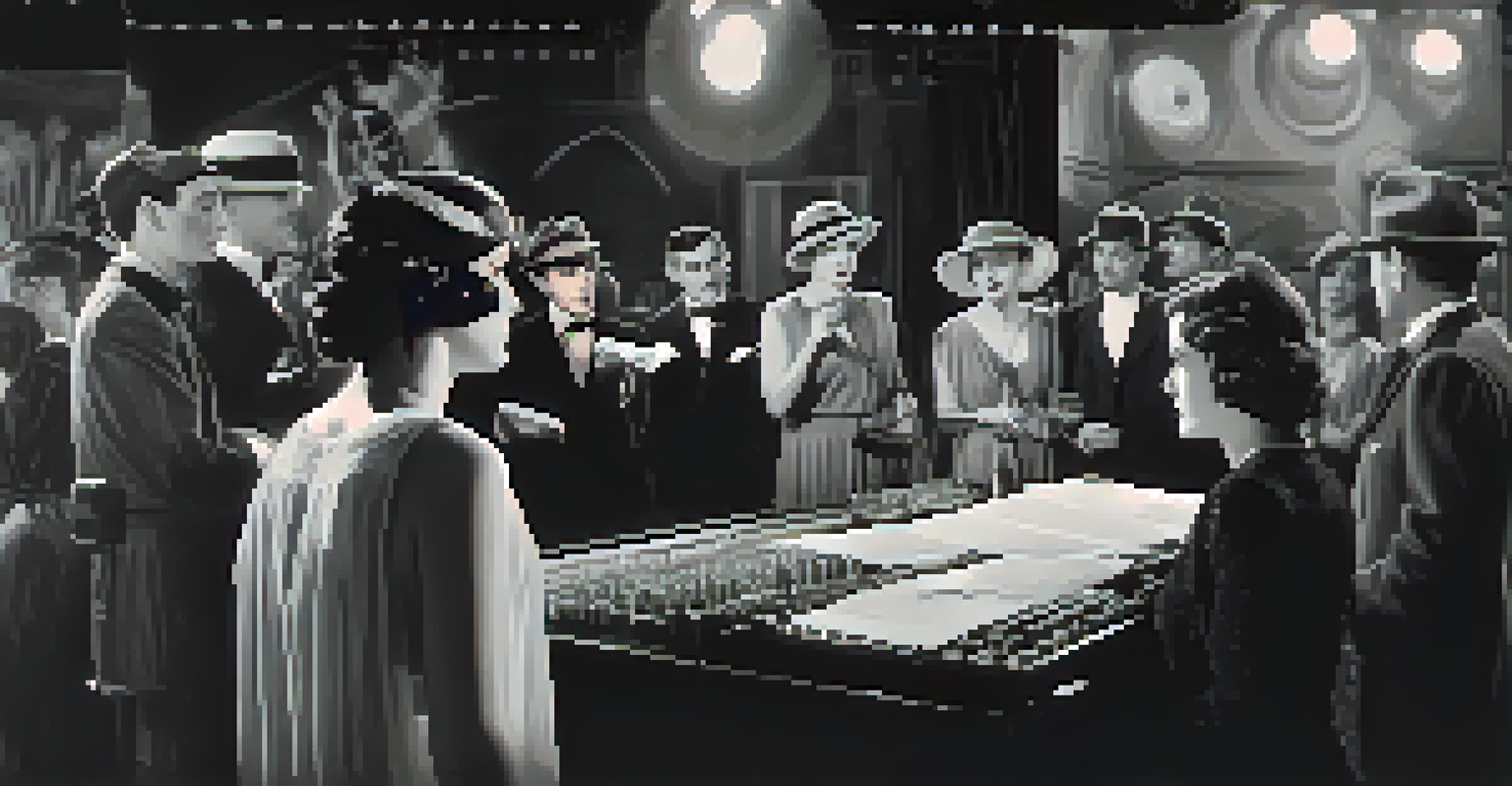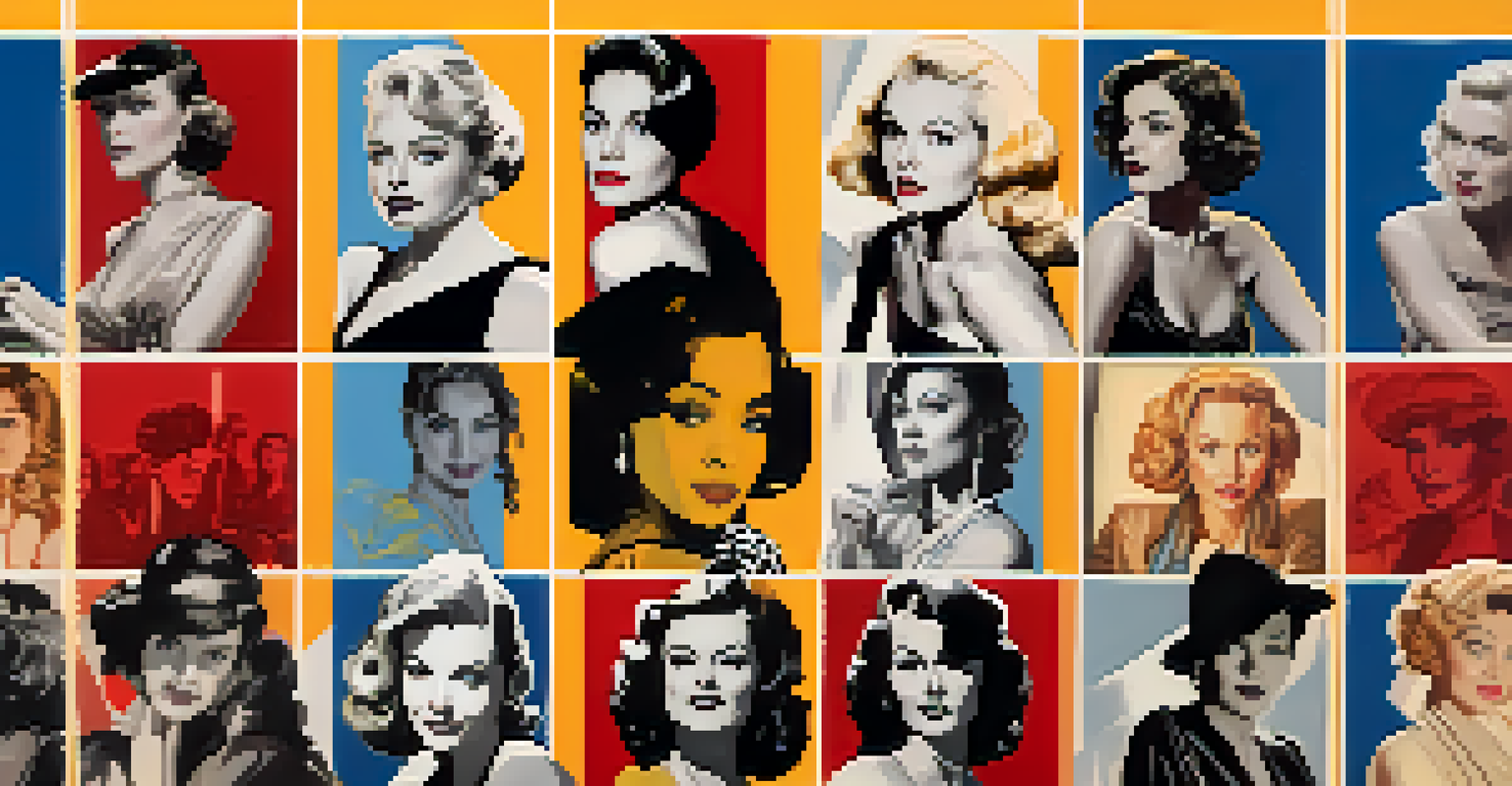The Role of Women in Classic Hollywood: A Historical Overview

Introduction to Women in Classic Hollywood
Classic Hollywood, a term that typically refers to the film industry from the 1910s to the 1960s, was a time of great change and creativity. Women played crucial roles behind and in front of the camera, often shaping the narratives we now consider iconic. Their influence was felt in various capacities, from scriptwriting to acting, and even directing. Understanding their contributions helps us appreciate the rich tapestry of film history.
I think the most important thing is to be yourself. The most important thing is to be true to yourself, and that means being true to what you want to do and not what the industry thinks you should do.
During this era, studios were predominantly male-dominated, yet women found ways to assert themselves creatively. They navigated the complex dynamics of Hollywood, often leveraging their talents to break through barriers. The resilience and ingenuity of these women laid the groundwork for future generations in the industry. Highlighting their stories is essential to recognizing the evolution of women's roles in cinema.
As we delve deeper into this historical overview, we will explore notable figures and movements that defined women's presence in classic Hollywood, illustrating their impact on filmmaking and storytelling.
The Silent Era: Pioneering Women in Film
The silent film era, which spanned from the late 1800s to the late 1920s, featured remarkable women who were instrumental in shaping the medium. Actresses like Mary Pickford and Lillian Gish became household names, captivating audiences with their performances. Importantly, women also worked behind the scenes as directors and producers, paving the way for cinematic storytelling.

Women like Lois Weber emerged as one of the first female directors, crafting compelling narratives that challenged societal norms. Despite the absence of sound, these films often tackled complex themes, showcasing women's experiences. This era set the stage for women to not only star in films but also to take charge of their narratives.
Women Pioneers in Early Cinema
During the silent film era, women like Mary Pickford and Lois Weber played crucial roles both in front of and behind the camera, shaping the cinematic landscape.
The silent film era demonstrated that women could be powerful forces in cinema, laying the groundwork for future successes. Their stories remind us that even in a male-dominated landscape, women carved out their own paths, significantly influencing the industry.
Golden Age of Hollywood: Stars and Filmmakers
The Golden Age of Hollywood, spanning from the 1930s to the 1960s, saw the rise of legendary actresses like Katharine Hepburn and Bette Davis. These stars not only defined an era but also broke stereotypes, portraying strong and complex female characters. Their performances challenged the traditional roles assigned to women, showcasing their versatility and depth as actresses.
The only way to deal with the future is to function efficiently in the now.
Meanwhile, women like Dorothy Arzner made significant strides as directors, becoming one of the few female filmmakers in a male-dominated industry. Arzner's work emphasized women's perspectives and experiences, influencing the storytelling landscape. This period marked a significant shift as women began to assert their place in front of and behind the camera.
The Golden Age was a time of both celebration and struggle for women in Hollywood. While they gained visibility and acclaim, systemic challenges persisted, highlighting the ongoing fight for equality within the industry.
The Role of Women Behind the Scenes
While much attention is given to actresses, women were also crucial behind the scenes in classic Hollywood. Screenwriters like Frances Marion and Mary McCall Jr. crafted compelling scripts that shaped many beloved films. Their narratives often provided a fresh perspective, enriching the overall storytelling landscape.
Additionally, women in editing and production roles played vital parts in the filmmaking process. They ensured that the final product reflected the vision of the filmmakers while also bringing their unique insights to the table. This behind-the-scenes influence was crucial in creating the polished films we admire today.
Golden Age: Breaking Stereotypes
In the Golden Age of Hollywood, actresses such as Katharine Hepburn and directors like Dorothy Arzner challenged traditional gender roles, asserting their influence in storytelling.
Despite their significant contributions, these women often remained uncredited or overshadowed by their male counterparts. Recognizing their work is essential to understanding the full scope of women's influence in classic Hollywood.
Challenges and Barriers Faced by Women
Despite their contributions, women in classic Hollywood faced numerous challenges and barriers. The industry was shaped by strict gender norms and expectations, often limiting women's opportunities. Many actresses had to navigate the pressures of maintaining a certain image while also striving for creative fulfillment.
Behind the camera, women encountered similar obstacles, often struggling for recognition and respect. The lack of representation in directing and producing roles highlighted the systemic issues within the industry. These barriers made it difficult for women to thrive, yet many persevered, carving out their own spaces.
Understanding these challenges helps us appreciate the tenacity of the women who fought for their rightful place in Hollywood. Their stories of resilience continue to inspire future generations of female filmmakers and actresses.
Impact on Future Generations of Filmmakers
The contributions of women in classic Hollywood laid the foundation for future generations of filmmakers and actresses. Their stories of perseverance and success continue to resonate, inspiring young women to pursue careers in the film industry. As we see an increase in female directors and writers today, we can trace their roots back to these pioneering women.
Additionally, the narratives crafted by these trailblazers have influenced modern storytelling, pushing for more diverse and authentic representations of women on screen. The legacy of these women is evident in the films that challenge stereotypes and celebrate female empowerment.
Lasting Impact on Future Filmmakers
The contributions of women in classic Hollywood continue to inspire modern filmmakers, promoting diverse and authentic representations of women in today's film industry.
By recognizing and honoring the achievements of women in classic Hollywood, we can continue to uplift and support the voices of women in today's film industry. Their impact is lasting, and their stories deserve to be told and celebrated.
Conclusion: Reflecting on Women's Contributions
In conclusion, the role of women in classic Hollywood is a testament to their talent, resilience, and influence in the film industry. From iconic actresses to groundbreaking directors, their contributions have shaped the narratives and aesthetics of cinema as we know it today. This historical overview highlights the importance of acknowledging their stories and contributions.
As we reflect on this era, it is crucial to recognize the ongoing challenges that women face in the industry. By understanding the past, we can advocate for a more inclusive and equitable future in filmmaking. Celebrating the achievements of these women is not just about honoring history but also about paving the way for future generations.

As we move forward, let us remember the legacies of these trailblazers and continue to support the voices of women in film. Their contributions are invaluable, and their stories deserve our attention and appreciation.